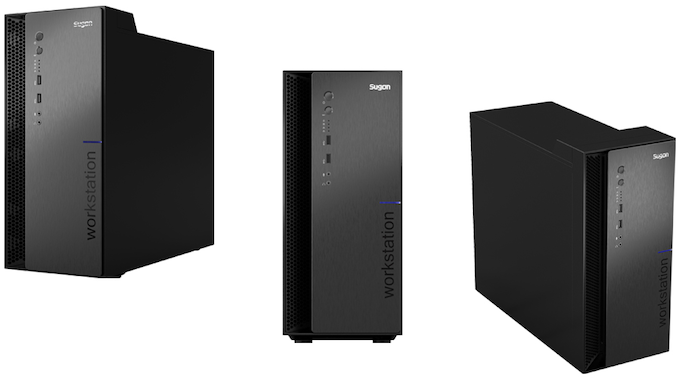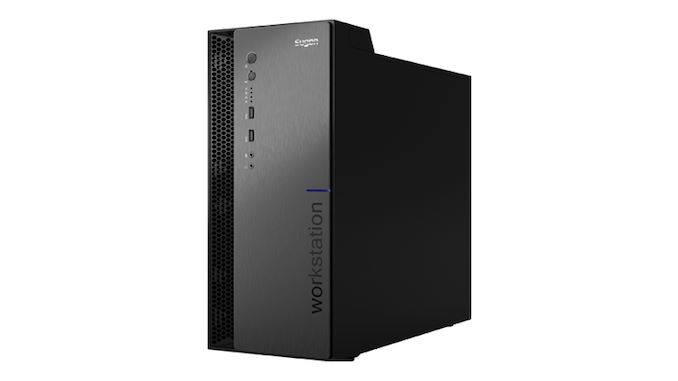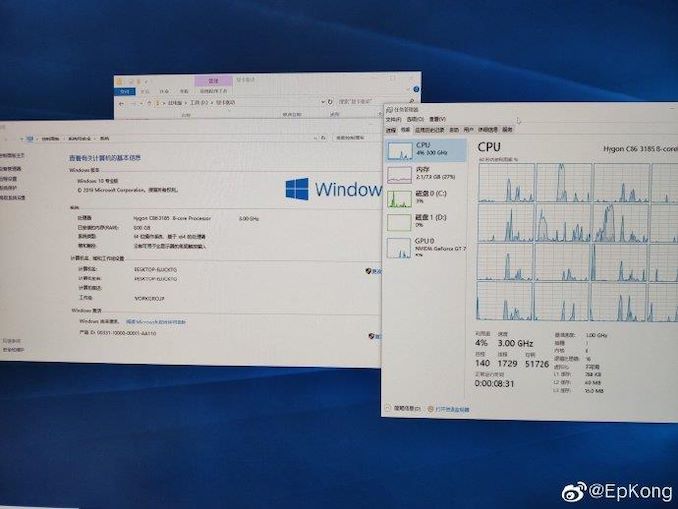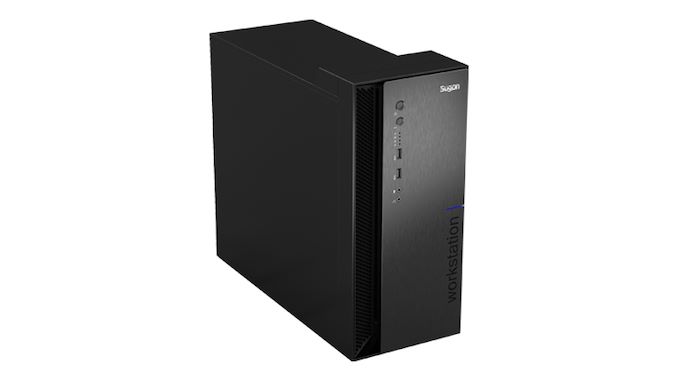Chinese Zen-Based CPU on Sale: Sugon Workstation with 8-Core Hugon Dhyana Processor
by Anton Shilov on May 23, 2019 12:00 PM EST
Sugon, an OEM of servers and workstations in China, has started selling of machines equipped with the Hugon Dhyana processors. These are processors based on AMD’s 1st Generation Zen microarchitecture. The CPUs feature up to eight cores and are compatible with the x86 instruction set architecture, thus can run all popular applications available today. The workstations can be equipped with the latest Quadro RTX or Quadro GV100 graphics cards from NVIDIA.
Back in 2016, AMD and Tianjin Haiguang Advanced Technology Investment Co., Ltd (THATIC, an investment arm of the Chinese Academy of Sciences) formed a joint venture to develop custom processors based on Zen microarchitecture aimed solely at the Chinese market. Under the terms of the agreement, AMD would provide its then latest x86 microarchitecture, whereas the rest of the SoC was to be designed in-house by the joint venture.
Last year the Hugon Dhyana CPUs finally saw the light of day, though their specifications remained largely unknown, whereas availability was limited to servers built and consumed by the Chinese government-funded organizations. Recently Shuguang Information Industry, a Chinese maker of servers and workstations that sells products under the Sugon trademark, started selling of its W330-H350 machines based on Hugon Dhyana 3000-series processors, revealing their specs as well as some other details.
As it turns out, Hugon’s Dhyana CPUs feature four (model 3138) or eight (models 3185 and 3188) Zen cores with SMT running at 3.6 GHz in the former case as well as 3.0 – 3.4 GHz in the latter case. We do not know cache sizes of these processors from official sources. Meanwhile, a Weibo user from China has published a screenshot allegedly taken on one of Hugon Dhyana-based machines which reveals that the eight-core Dhyana 3185 features 768 KB L1 cache, 4 MB L2 cache, and 16 MB L3 cache, the same configuration as AMD’s contemporary eight-core Ryzen processors.
Considering how significantly Hugon’s Dhyana 3000-series CPUs resemble AMD’s Ryzen, there are several obvious questions that come to mind about these processors:
- First. What’s the difference between Dhyana and Ryzen chips? Since Hugon’s CPUs are intended for servers that are used by various organizations including those controlled by the government, it is logical to expect the chips to include proprietary IP. Meanwhile, semi-custom server CPUs are nothing new, so the point of creating the JV to get such processors is unknown. Unless, of course, THATIC wants to build certain CPUs for sensitive applications like government, military, aerospace, secret services, and so on. Either that, or these are just like Ryzen CPUs with some custom firmware.
- Second, are Hugon’s Dhyana the only Zen-based CPUs developed by the JV between AMD and THATIC? In the end, Dhyana may not be intended for military, aerospace, or security applications.
- Third, which foundry is contracted to make Hugon’s Dhyana? Military and secret services would like everything to be made in the country, but the most advanced process technology that SMIC officially has is 28 nm and it is unclear whether this tech is efficient enough for eight-core x86 CPUs with large caches.
UPDATE 5/24: According to Hao Feng from Hugon, secure encryption virtualization (SEV) pipeline of Dhyana processors works similarly to SEV of AMD’s Ryzen, but uses China national standard cryptographic algorithms SM2, SM3, SM4 instead of RSA, ECDSA,
ECDH, SHA, and AES.
SM2, which is similar to ECDH, is based on ECC (elliptic curve cryptography) yet uses two random public keys. This one could used for digital signature, key exchange, and asymmetric cryptography. SM3 is a hash algorithm, similar to SHA-256. SM4 is a block cipher algorithm, similar to AES-128.
As far as the Sugon W330-H350 machine is concerned, it has four DIMM slots (supporting up to 256 GB of memory), storage bays supporting 2.5-inch and 3.5-inch HDDs/SSDs, one PCIe 3.0 x16 slot, two PCIe 3.0 x8 slot (work in x4 and x1 modes), two GbE ports, multiple USB 3.0 connectors, and so on. Since we are dealing with a workstation, Sugon offers to install the whole range of NVIDIA’s Quadro graphics cards, including Nvidia Quadro P400/P620/P1000/P2000/P4000/P5000/P6000, Quadro GV100, or Quadro RTX5000/6000/8000*. Depending on the configuration, Sugon equips its workstations with a 300 W or 600 W PSU. Measuring 400x175x400 mm (30.8 liters), the system weighs around 10 kilograms.
If anyone at Sugon happens to be reading this news, please get in contact with our Senior Editor Ian Cutress (ian@anandtech.com), as we'd like to arrange a review unit if possible.













47 Comments
View All Comments
Skeptical123 - Friday, May 24, 2019 - link
Bingo!Colin1497 - Thursday, May 23, 2019 - link
Seems a reasonably safe bet that these are made at TSMC, Global Foundries, or one of the Global Foundries technology partners with a design rules option similar to what they've used at GloFo (Samsung?) and that the cores are essentially copy/paste designs. I can't imagine AMD laid the cores out for someone else's process, but I believe at this point that they've done zen about both GloFo and TSMC?sutamatamasu - Thursday, May 23, 2019 - link
This chips have potential to use 14nm from SMIC since primary focus is for government because GloFo FAB in China only produce for 22 FDX chipset.RaduR - Thursday, May 23, 2019 - link
Don't they need Intel X86 license?How is that possible?
R0H1T - Thursday, May 23, 2019 - link
AMD doesn't need a separate license, just like Intel don't need one for x64, not to mention the JV (AMD and THATIC) under which these processors are made is majority owned by AMD.iBoMbY - Thursday, May 23, 2019 - link
Yes, this whole JV thing was constructed to put it under the AMD/Intel cross-patent license agreement umbrella. Intel can't do jack about it.webdoctors - Thursday, May 23, 2019 - link
Its pretty shady that I can't license and make my own x86 processor but some company in China can with their "transparent" announcement that its just licensing of AMD processors and not just the x86 license. If that's true, it should be identical to 1st gen Ryzen, but if so why make it at all? AMD already makes semi-custom IP for Sony/MS. Seems shady.How long do these licenses last? After 40 yrs will someone finally be able to make an x86 compatible CPU without Intel/AMD permission?!
iBoMbY - Thursday, May 23, 2019 - link
The "x86 license" mostly is a US copyright thing. AMD and Intel share pretty much everything, this is why Intel can use AMD64 without any restriction. The JV is technically a AMD subsidiary with AMD in control of >50%. And what they are doing there is not semi-custom, but fully-custom with licensed IPs. It looks like they build in their own encryption standard stuff for example.AMD gets fees and royalties, the US government has a lot less options to kill/control this, and China can build whatever CPUs they need.
Yojimbo - Tuesday, May 28, 2019 - link
A copyright thing? What do you mean? Maybe you mean patent...And AMD is only a majority stakeholder. To one of the formed joint ventures, the one that owns the rights to the patents. That is to get around the licensing agreement between AMD and Intel and not because of the US government.
If the US government wanted to declare it a national security issue they could. They won't let Intel or NVIDIA give specialized chips that go into Chinese supercomputers. I am sure they could easily argue some similar thing to put an end to this arrangement if they wanted to.
Freeb!rd - Thursday, May 23, 2019 - link
AMD is the MAJORITY (51%) stakeholder in HMC, Haiguang Microelectronics Co. Ltd. They are the company that actually signs a contract with a Foundry which produces them and HMC provides the chips back to Hygon (not sure why Anandtech can't get the company name correct)... also this product can only be sold in China and not exported.It is really AMD's way of prying CPU sales in China away from Intel (desktop & server). I would assume that the Security Processor (trusted zone) is not part of these CPU designs. 1) because that was built on ARM tech (which supposedly is not part of the IP license) and 2) doubtful that China wants that in the chip to begin with...
https://www.tomshardware.com/news/china-zen-x86-pr...
"To stay within the legal boundaries, HMC licenses the IP to Hygon, which designs the x86 chips and then sells the design back to HMC.
HMC then employs a foundry to fab the end product (likely China Foundries or TSMC). Confusingly, HMC then transfers the chips back to Hygon (the same company that designed them), which then sells the Dhyana processors.
And thus, AMD's licensing of the x86 IP stays within the legal boundaries."